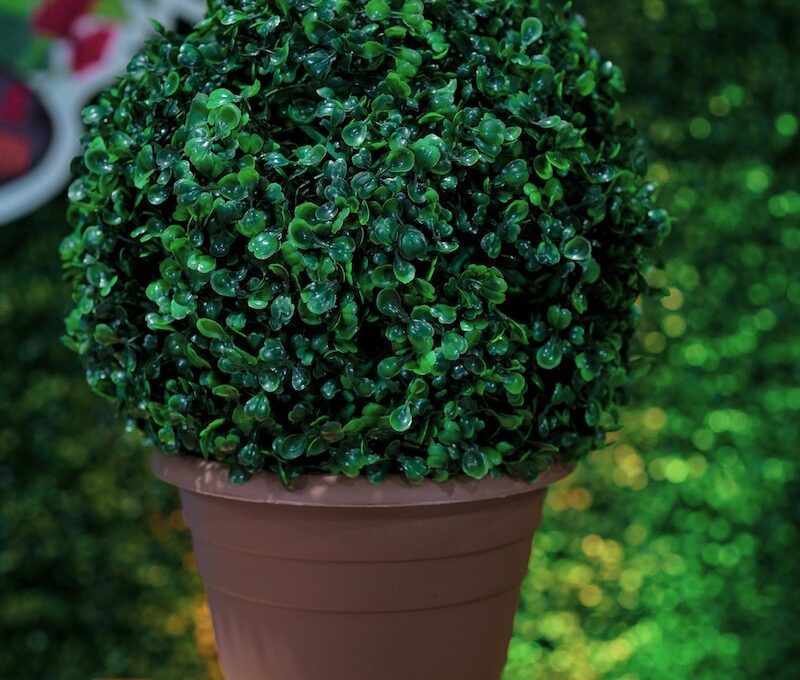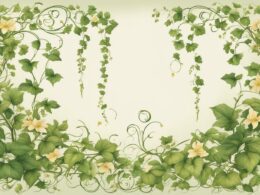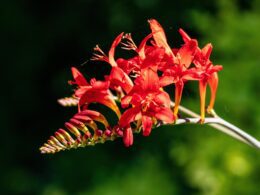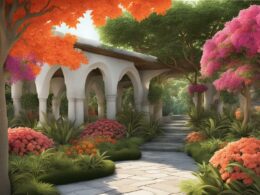Are you looking to add some color, texture, and intrigue to your landscape all year round? Choosing the right bushes and shrubs can make a significant impact on your outdoor space, regardless of the season.
In this blog post, we’ll explore various types of evergreen and blooming shrubs that maintain their beauty throughout the year—from azaleas to witch hazel. We’ll also discuss maintenance tips for keeping these plants thriving and highlight the benefits they bring to your property.
Key Takeaways
- Evergreen shrubs like boxwood, holly, juniper, barberry, yew, and arborvitae can provide year – round interest to any garden or landscape.
- Shrubs that bloom all year round such as azalea, bridal wreath spiraea, witch hazel, lantana and California lilac are also great options for adding color to your outdoor space.
- Colorful shrubs like crape myrtle, spiraea, bottle brush, vitex abelia and smoke bush can add vibrancy and interest to any garden.
- Proper maintenance practices including proper planting location selection based on preferred soil type and moisture levels per plant species preference or tolerance. Timing of planting is equally important especially for deciduous bushes which varies depending on the species.
Types Of Shrubs That Provide Year-Round Interest
There are several types of shrubs that can provide year-round interest, including evergreen shrubs, those that bloom all year round, and colorful shrubs.
Evergreen Shrubs
Evergreen shrubs are a vital addition to any garden or landscape, as they retain their foliage and color all year round. This makes them the perfect choice for homeowners looking to create visual interest in outdoor spaces that can be enjoyed throughout every season.
Some popular examples of evergreen shrubs include boxwood, holly, juniper, barberry, yew, and arborvitae. Boxwoods are particularly versatile; they can be sculpted into creative topiary designs or used as elegant privacy hedges.
Holly bushes boast glossy green leaves and vibrant red berries during winter months which create striking contrast against snow-covered backdrops.
Shrubs That Bloom All Year Round
There are several shrubs that provide year-round interest by blooming in every season. For example, the azalea offers a pop of color with its pink or white flowers in early spring and again in fall.
The bridal wreath spiraea has delicate white blooms that cover the branches in late spring, while witch hazel produces fragrant yellow or orange flowers from fall to winter.
Lantana is a colorful option that attracts butterflies with its red, orange, and yellow blooms throughout the year.
Some other flowering shrubs can also add color to your garden throughout the seasons. The crape myrtle is a popular choice for summer bloomers with its showy pink or purple flowers, and bottle brush produces striking red spiky blossoms from spring through summer.
Colorful Shrubs
Colorful shrubs can add vibrancy and interest to any garden or landscape. Some of the best examples of colorful shrubs include crape myrtle, spiraea, bottle brush, vitex, gardenia, abelia, and smoke bush. Crape myrtle is known for its beautiful hues of pink, red, and purple blooms that appear in late summer.
Spiraea comes in a range of colors depending on the variety chosen but generally produces showy pink blossoms during the summer months. Bottle brush gets its name from its vibrant red flowers that resemble a bottlebrush and bloom throughout much of the year.
Gardenia is another popular option with its large white fragrant blooms that make it perfect for adding sensory appeal to your garden.
Best Evergreen Bushes For Year-Round Beauty
Boxwood, holly, juniper, barberry, yew, and arborvitae are some of the best evergreen bushes for year-round beauty in your landscape.
Boxwood
Boxwood is a classic evergreen shrub that offers year-round interest with its dense, bright green foliage. It’s an excellent choice for hedges, borders, and topiaries due to its ability to be pruned into different shapes and sizes.
Boxwoods are also low-maintenance plants that can tolerate both sun and shade, making them versatile in any landscaping setting. With their durability and winter hardiness, boxwoods are a reliable option for those seeking a four-season plant that provides consistent greenery through all types of weather conditions.
Holly
Holly is a popular evergreen shrub that provides year-round beauty to any landscape. With its glossy, dark-green leaves and bright-red berries, holly is a classic choice for holiday decorations.
It also offers privacy and noise reduction when grown as a hedge. There are several types of holly available, including American holly, English holly, and Japanese holly.
They all have their unique features but generally require little maintenance once established. Holly prefers well-drained soil and partial to full sunlight exposure.
Some varieties can grow up to 50 feet tall while others remain compact at only a few feet in height.
Juniper
Juniper is a popular evergreen shrub that can provide year-round foliage to your landscape. It has needle-like leaves that are usually green or blue-green in color and sometimes gray or yellow.
Junipers come in various shapes and sizes, with some growing as small groundcovers while others reach up to 30 feet tall. Some popular juniper varieties include the Blue Arrow, the Spartan, and the Old Gold.
Junipers are low-maintenance plants and can survive in different environments, making them an ideal choice for landscaping projects.
Barberry
Barberry is a beautiful evergreen shrub that provides year-round color and interest to any garden. It has small, shiny leaves that range in color from green to red and produce bright yellow flowers in the spring.
Barberry is not only easy to grow but also low-maintenance, making it an ideal choice for busy gardeners. It can thrive in full sun or partial shade and adapts well to different soil types.
In addition to its ornamental value, barberry has several other benefits that make it a great addition to any landscape design. For instance, its thorny branches provide a natural barrier against intruders while also offering shelter for birds and other wildlife.
Yew
Yew is a versatile evergreen shrub that provides year-round interest in the garden. With its glossy, dark green needles and red berries, it’s a popular choice for hedging and border planting.
Yew is also known for its durability, making it an excellent option for low-maintenance landscapes. It can tolerate shade and drought conditions, but prefers well-drained soil.
Some other noteworthy features of yew include their slow growth rate and longevity – some species can live up to 400 years! They are also resistant to deer browsing, making them an ideal choice for gardens with high wildlife activity.
A few popular varieties of yew include Hicksii yew, Densiformis yew, and the Golden Irish yew – each with unique characteristics like color variations or growth habits.
Arborvitae
Arborvitae, also known as the White Cedar, is a popular evergreen shrub that makes for an excellent year-round addition to any garden. This hardy shrub is low maintenance and can tolerate extreme cold temperatures, making it ideal for colder climates.
Arborvitae comes in several varieties with different sizes and shapes such as Emerald Green, Golden Globe, and Little Giant. They are commonly used for hedges or privacy screens due to their dense foliage that provides natural barriers from neighbors’ prying eyes.
Additionally, arborvitae has antioxidant properties which make them great air purifiers.
Maintenance Tips For Year-Round Bushes
To keep your year-round bushes looking their best, make sure to choose the right location for planting, water and fertilize properly, prune as needed, and identify and treat any pests or diseases; read on for more detailed tips!
Choosing The Right Location
Choosing the right location is crucial when selecting year-round shrubs for your garden. Most evergreen plants need at least 6 hours of direct sunlight each day to thrive, while some shade-tolerant shrubs like hydrangeas and Japanese maple trees thrive in partial or full shade.
It is important to understand a plant’s preferred soil type and moisture levels before planting – for example, azaleas prefer well-draining acidic soil while juniper bushes can tolerate a range of soils.
One great example of properly locating plants is holly shrubs which are known for their year-round interest. These low maintenance evergreens require full sun but they also adapt well to varying light conditions such as partial shade and light filtered sun.
They should be planted in well-drained soils with regular watering during dry periods because over-watering can cause root rot which will damage the plant severely.
Planting At The Right Time
Choosing the right time to plant your year-round bushes is crucial for their growth and long-term health. Generally, it’s best to plant evergreen shrubs in spring or fall when temperatures are cooler and rainfall is more consistent.
For deciduous bushes, timing can vary depending on the species. For instance, flowering shrubs like lilacs should be planted in the early spring before they start producing buds, while those that bloom later like rose of Sharon should be planted after they’ve finished blooming in late summer or early fall.
By taking care to choose the right planting time and ensuring that your soil is well-prepared with fertilizer and compost, you’ll give your year-round bushes a strong foundation for years of beauty and enjoyment.
Watering And Fertilizing Properly
Proper watering and fertilizing are crucial to maintaining healthy shrubs all year round. Generally, newly planted bushes require more frequent watering until they establish their root systems.
After that, it’s important to water deeply but infrequently, allowing the soil to dry out slightly between waterings.
As for fertilizing, it’s best to do so during the growing season – typically from spring through early fall – using a slow-release fertilizer designed specifically for shrubs.
Avoid over-fertilizing as this can lead to excessive growth and foliage at the expense of flowers or fruit production. Remember that different types of shrubs have unique nutrient requirements, so be sure to select an appropriate fertilizer accordingly.
Pruning As Needed
Regular pruning is essential for keeping your year-round shrubs in good health and maintaining their shape. It’s a task that can be done throughout the year, but it’s important to know when to prune each type of shrub and how much you should remove.
Most evergreen plants benefit from being lightly pruned every year or two to keep them dense and compact. For instance, boxwoods should be trimmed in late winter or early spring before new growth appears.
When pruning, make sure to use sharp tools and cut just above an outward-facing bud or leaf node at a slight angle. This will encourage new growth while preventing damage to the plant.
Removing dead or diseased branches promptly will also help prevent pests and diseases from spreading throughout your landscape.
Identifying And Treating Pests And Diseases
It’s important to keep an eye out for any pests or diseases that may affect your year-round bushes. One common issue is spider mites, which can cause discoloration and damage to leaves.
To treat this problem, try using a natural insecticidal soap or oil spray. Another potential pest is the scale insect, which sucks sap from plants and weakens them over time.
Diseases such as powdery mildew and blight can also impact your shrubs, causing leaf spots and wilted foliage. To prevent these issues, make sure you’re planting in well-draining soil with good air circulation.
If problems do arise, try pruning away affected branches and treating with a fungicide if needed.
Benefits Of Year-Round Bushes
Year-round bushes provide a number of benefits to your outdoor space, including year-round greenery, privacy and noise reduction, and increased property value. Discover how you can incorporate these low-maintenance plants into your landscaping with our maintenance tips.
Provides Year-Round Greenery
Year-round shrubs provide a consistent greenery that can give your outdoor space structure and definition even in the midst of winter. Evergreen shrubs like boxwood, holly, juniper, barberry, yew, and arborvitae are great examples of plants that offer year-round color and texture.
Some semi-evergreen varieties that shed some leaves but retain enough foliage to maintain their shape during winter include azalea, spiraea, bottle brush buckeye, California lilac and smoke bush.
Additionally, colorful shrubs like abelia change colors with the seasons while still providing interest no matter what time of year it is. Year-round greenery is not only aesthetically pleasing; it also provides privacy by screening unwanted views or buffering against noise pollution in bustling neighborhoods.
Offers Privacy And Noise Reduction
Year-round shrubs are not only visually appealing but also practical for creating privacy and reducing noise pollution. For instance, evergreen shrubs like arborvitae and yew can form a dense screen when planted closely together, making them ideal for blocking out neighbors or busy roads.
Not only do these year-round bushes provide visual barriers, but they can also dampen noise levels by absorbing sound waves. This is especially useful in urban environments where traffic or construction noise may be prevalent.
In summary, year-round shrubs offer more than just aesthetic appeal – they are versatile plants that can improve your quality of life by offering privacy and reducing unwanted noise levels in outdoor areas.
Increases Property Value
Landscaping is a great way to increase the value of your property, and using year-round bushes in your design can be especially effective. A well-maintained garden with vibrant greenery and pops of color can give your home curb appeal and make it more attractive to potential buyers.
Evergreen shrubs, like boxwoods or junipers, that keep their foliage throughout the year are low maintenance options that will add visual interest no matter the season. Additionally, colorful flowering bushes like crape myrtles or smoke bush bring an extra pop of personality to your landscape.
FAQ: What Bushes Live All Year Round?
Q: What are some common evergreen shrubs?
A: Some common evergreen shrubs include rhododendron, boxwood, gardenia, holly, arborvitae, wintercreeper, azalea, mountain laurel, cypress, and false cypress.
Q: What is a rhododendron?
A: A rhododendron is an evergreen shrub that typically produces clusters of bell-shaped flowers in spring or summer.
Q: Are there dwarf evergreen shrub varieties available?
A: Yes, many evergreen shrubs have dwarf varieties available, which are great for smaller gardens or as foundation plantings.
Q: What are the growing conditions for mountain laurel?
A: Mountain laurel prefers moist, well-drained soil and can tolerate partial to full shade. It is hardy in zones 5-9.
Q: What is a false cypress?
A: A false cypress is a type of evergreen shrub with dark green foliage that can be variegated with light green or yellow. It is hardy in zones 4-8.
Q: What is wintercreeper?
A: Wintercreeper is an evergreen ground cover that grows well in most soils and can tolerate frost. It is hardy in zones 5-9.
Q: How can I add year-round color to my landscape with evergreen shrubs?
A: There are many varieties of evergreen shrubs that offer year-round color with their dark green leaves and occasional blooms in the spring or summer. Here are some examples of evergreen shrubs:
- Boxwood (Buxus sempervirens): This is a classic, highly versatile shrub that can be used as a hedge, in a formal garden, or even in a container.
- Holly (Ilex species): This shrub is known for its glossy green leaves and bright red berries during the winter season.
- Azalea (Rhododendron species): This is a popular shrub for its colorful blooms in the spring, but it also has evergreen foliage that adds year-round interest.
- Camellia (Camellia species): This shrub has glossy green leaves and colorful blooms in the winter and spring, making it a great choice for an accent or feature plant.
- Japanese Pieris (Pieris japonica): This shrub has dark green leaves and clusters of fragrant white, pink, or red flowers in the spring.
- Laurel (Prunus laurocerasus): This is a tough, low-maintenance shrub with dark green, shiny leaves that can be used as a hedge or a background plant.
- Juniper (Juniperus species): This shrub comes in many different shapes and sizes, with blue-green or dark green foliage, and can be used for groundcover, in a rock garden, or as a shrub.
- Yew (Taxus species): This is a slow-growing evergreen shrub with dark green needles that can be used for hedges, topiaries, or as an accent plant.
Q: How often should I prune my evergreen shrubs?
A: It is recommended to prune evergreen shrubs up to three times a year to maintain their shape and encourage healthy growth.
Q: What should I look for when purchasing an evergreen shrub?
A: When purchasing an evergreen shrub, consider its hardiness zone, mature size, growing conditions, and any specific blooms or foliage you desire for best results.
Q: What are some fragrant evergreen shrubs to add to my garden?
A: Some evergreen shrubs with fragrant blooms include gardenia, mountain laurel, and some varieties of rhododendron.
Conclusion
In conclusion, there are many options for bushes that can provide year-round interest and enhance the beauty of your outdoor space.
Whether you prefer evergreen shrubs or deciduous ones with bursts of color, there are plenty to choose from. Keep in mind that proper maintenance, including watering, fertilizing, pruning and identifying pests and diseases is necessary for optimal growth.
By incorporating these beautiful plants into your yard design, not only will you enjoy their beauty all year round but it can also add value to your property.









